外研版英语动词形式专练课件(15张)
图片预览

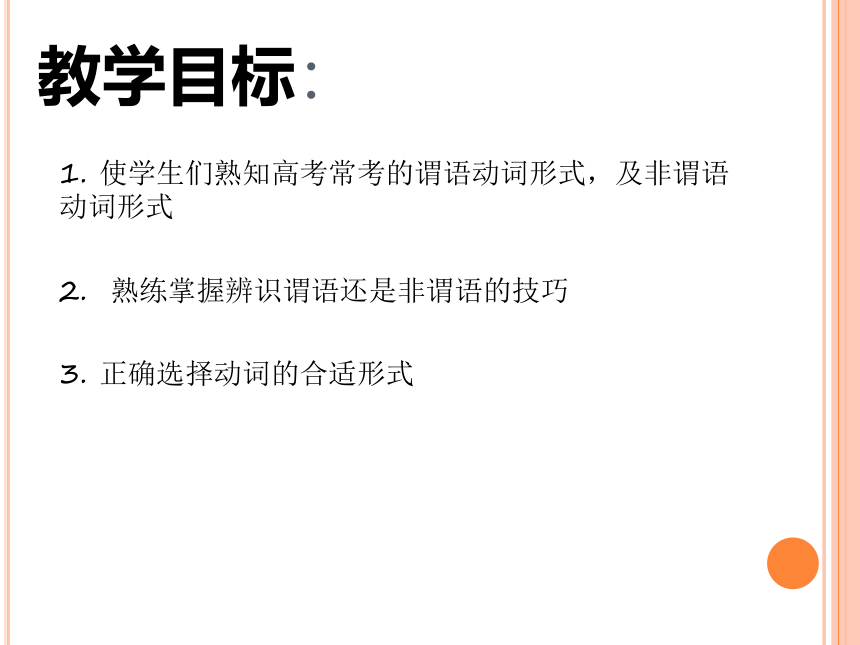
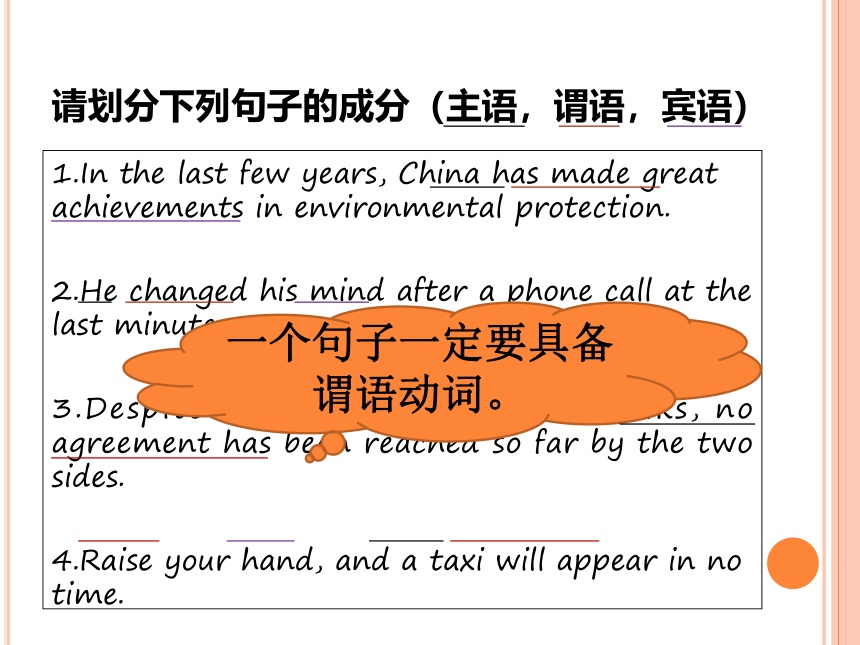
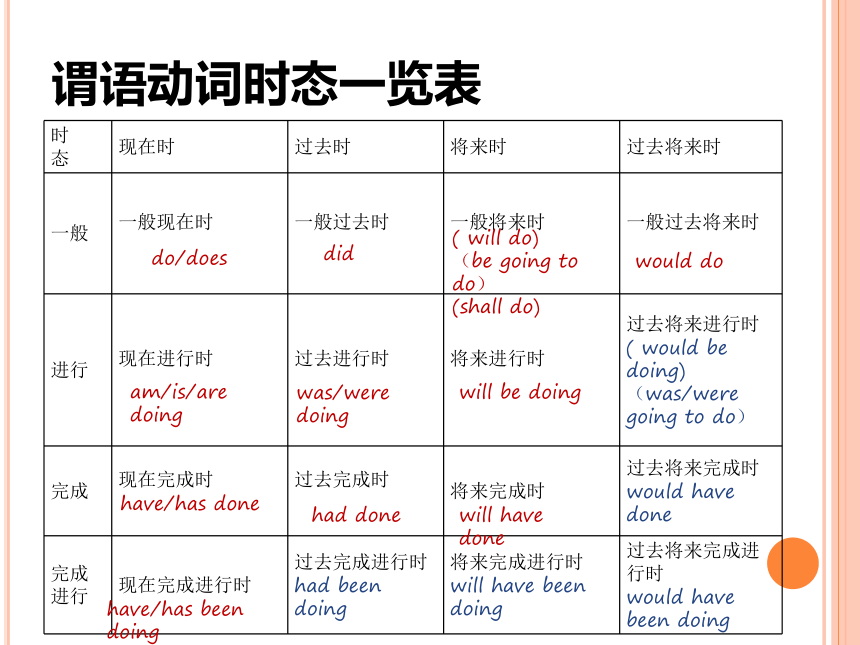

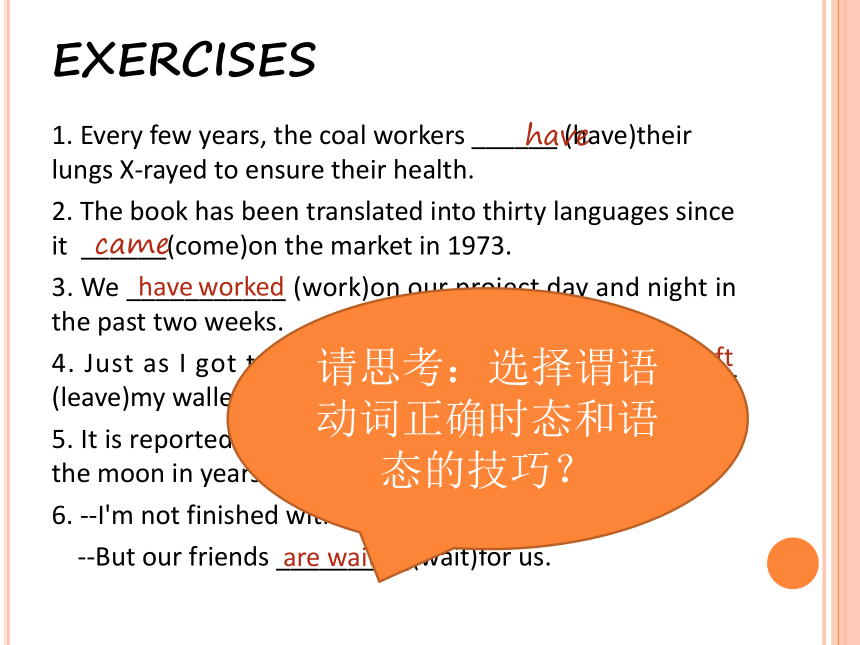
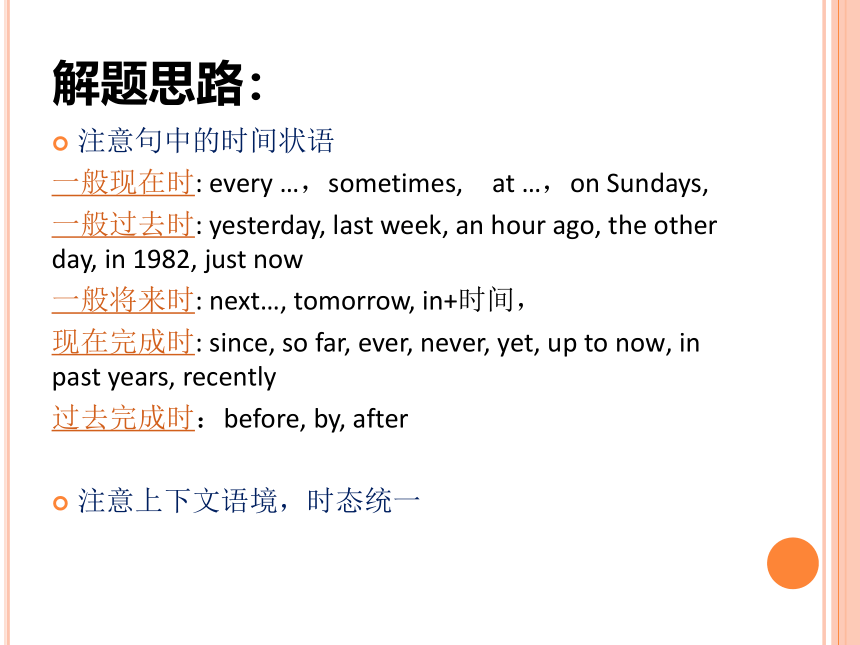
文档简介
动词形式专练
谓语动词及非谓语动词
教学目标:
1. 使学生们熟知高考常考的谓语动词形式,及非谓语动词形式
2. 熟练掌握辨识谓语还是非谓语的技巧
3. 正确选择动词的合适形式
请划分下列句子的成分(主语,谓语,宾语)
1.In the last few years, China has made great achievements in environmental protection.
2.He changed his mind after a phone call at the last minute.
3.Despite the previous rounds of talks, no agreement has been reached so far by the two sides.
4.Raise your hand, and a taxi will appear in no time.
一个句子一定要具备谓语动词。
谓语动词时态一览表
时
态
现在时
过去时
将来时
过去将来时
一般
一般现在时
一般过去时
一般将来时
一般过去将来时
进行
现在进行时
过去进行时
将来进行时
过去将来进行时
( would be doing)
(was/were going to do)
完成
现在完成时
过去完成时
将来完成时
过去将来完成时
would have done
完成进行
现在完成进行时
过去完成进行时
had been doing
将来完成进行时
will have been doing
过去将来完成进行时
would have been doing
do/does
did
( will do)
(be going to do)
(shall do)
would do
am/is/are doing
was/were doing
will be doing
have/has done
had done
will have done
have/has been doing
谓语动词被动语态形式一览表
被动语态
一般现在时
一般将来时
一般过去时
现在进行时
过去进行时
现在完成时
过去完成时
情态动词
过去将来时
am\is\are+done(V. p.p)
will+be+done(V. p.p)
was\were+done(V. p.p)
am\is\are+being+done(V. p.p)
was\were+being+done(V.p.p)
have\has+been+done(V. p.p)
had+been+done(V. p.p.)
情态动词+be+done(V. p.p.)
would/should be + done(V. p.p.)
EXERCISES
1. Every few years, the coal workers ______ (have)their lungs X-rayed to ensure their health.
2. The book has been translated into thirty languages since it ______(come)on the market in 1973.
3. We ___________ (work)on our project day and night in the past two weeks.
4. Just as I got to the school gate, I realized I ______ (leave)my wallet in the cafe.
5. It is reported that a space station __________(build) on the moon in years to come.
6. --I'm not finished with my dinner yet.
--But our friends _________ (wait)for us.
came
have
have worked
had left
will be built
are waiting
请思考:选择谓语动词正确时态和语态的技巧?
解题思路:
注意句中的时间状语
一般现在时: every …,sometimes, at …,on Sundays,
一般过去时: yesterday, last week, an hour ago, the other day, in 1982, just now
一般将来时: next…, tomorrow, in+时间,
现在完成时: since, so far, ever, never, yet, up to now, in past years, recently
过去完成时:before, by, after
注意上下文语境,时态统一
划线句中的谓语动词
1. Last night, there were millions of people watching the opening ceremony live on TV.
2. There is no greater pleasure than lying on my back in the middle of the grassland, staring at the night sky.
3.To free ourselves from the physical and mental tensions, we each need deep thought and inner quietness.
Clearly and thoughtfully written, the book inspires confidence in students who wish to seek their own answers.
思考:用非谓语动词的前提条件?
句中已有谓语动词
没有连词
非谓语动词的基本概念和形式
在句子中做谓语以外的句子成分的动词形式叫非谓语
动词。
非谓语动词形式:不定式、ing形式、过去分词
不定式的形式:
进行式
语态
时态
一般式
完成式
主动
被动
to do
to have done
to be done
to have been done
to be doing
动名词和现在分词的形式
语态
时态
一般式
完成式
主动
被动
doing
being done
having done
having been done
过去分词:done
否定形式:
not +不定式,not + 动名词,not +现在分词
1. ______(give)more attention, the trees could have grown better.
2. ______(arrive) at the railway station, we had a break, only_______ (find) the train had left.
3.When______ (ask) why he walked in without permission, he just stared at us and said nothing.
4.__________ (not know) his telephone number, she had some difficulty getting in touch with Bill.
5. _______(hold) his head high, the manager walked into the room to attend the meeting__________(hold) then.
Given
Arriving
to find
asked
Not knowing
Holding
being held
非谓语动词解题步骤
1. 解析句子结构,判断考谓语动词还是非谓语动词;
2. 找准设空动词的逻辑主语,确定该动词与逻辑主语是什么关系(主动还是被动);
3. 搜索句子中相关的时间信息,确定非谓语动词的恰当 形式;
4. 将该选项置入空中,看能否做到字从意顺,传达有效信息、完成交际任务。
1.The first textbooks ______ for teaching English as a foreign language came out in the 16th century.
A.to be written B. written
C. being written D. having written
2.By the end of last year, another new gymnasium _____ in Beijing.
A. would be completed B. was being completed
C. has been completed D. had been completed
3.The missing boys were last seen ______ near the river.
A.to play B. play C.to be playing D. playing
B
D
D
4.If city noises ________ from increasing,people ________ shout to be heard even at the dinner table 20 years from now.
A. are not kept;will have to B.are not kept; have to C.do not keep; will have to D.do not keep; have to
5.The murderer was brought in, with his hands ______ behind his back.
A. to be tied B. being tied C. tied D. having tied
6.There was terrible noise ______ the sudden burst of light.
A. followed B. following
C. to be followed D. being followed
A
C
B
THE END
谓语动词及非谓语动词
教学目标:
1. 使学生们熟知高考常考的谓语动词形式,及非谓语动词形式
2. 熟练掌握辨识谓语还是非谓语的技巧
3. 正确选择动词的合适形式
请划分下列句子的成分(主语,谓语,宾语)
1.In the last few years, China has made great achievements in environmental protection.
2.He changed his mind after a phone call at the last minute.
3.Despite the previous rounds of talks, no agreement has been reached so far by the two sides.
4.Raise your hand, and a taxi will appear in no time.
一个句子一定要具备谓语动词。
谓语动词时态一览表
时
态
现在时
过去时
将来时
过去将来时
一般
一般现在时
一般过去时
一般将来时
一般过去将来时
进行
现在进行时
过去进行时
将来进行时
过去将来进行时
( would be doing)
(was/were going to do)
完成
现在完成时
过去完成时
将来完成时
过去将来完成时
would have done
完成进行
现在完成进行时
过去完成进行时
had been doing
将来完成进行时
will have been doing
过去将来完成进行时
would have been doing
do/does
did
( will do)
(be going to do)
(shall do)
would do
am/is/are doing
was/were doing
will be doing
have/has done
had done
will have done
have/has been doing
谓语动词被动语态形式一览表
被动语态
一般现在时
一般将来时
一般过去时
现在进行时
过去进行时
现在完成时
过去完成时
情态动词
过去将来时
am\is\are+done(V. p.p)
will+be+done(V. p.p)
was\were+done(V. p.p)
am\is\are+being+done(V. p.p)
was\were+being+done(V.p.p)
have\has+been+done(V. p.p)
had+been+done(V. p.p.)
情态动词+be+done(V. p.p.)
would/should be + done(V. p.p.)
EXERCISES
1. Every few years, the coal workers ______ (have)their lungs X-rayed to ensure their health.
2. The book has been translated into thirty languages since it ______(come)on the market in 1973.
3. We ___________ (work)on our project day and night in the past two weeks.
4. Just as I got to the school gate, I realized I ______ (leave)my wallet in the cafe.
5. It is reported that a space station __________(build) on the moon in years to come.
6. --I'm not finished with my dinner yet.
--But our friends _________ (wait)for us.
came
have
have worked
had left
will be built
are waiting
请思考:选择谓语动词正确时态和语态的技巧?
解题思路:
注意句中的时间状语
一般现在时: every …,sometimes, at …,on Sundays,
一般过去时: yesterday, last week, an hour ago, the other day, in 1982, just now
一般将来时: next…, tomorrow, in+时间,
现在完成时: since, so far, ever, never, yet, up to now, in past years, recently
过去完成时:before, by, after
注意上下文语境,时态统一
划线句中的谓语动词
1. Last night, there were millions of people watching the opening ceremony live on TV.
2. There is no greater pleasure than lying on my back in the middle of the grassland, staring at the night sky.
3.To free ourselves from the physical and mental tensions, we each need deep thought and inner quietness.
Clearly and thoughtfully written, the book inspires confidence in students who wish to seek their own answers.
思考:用非谓语动词的前提条件?
句中已有谓语动词
没有连词
非谓语动词的基本概念和形式
在句子中做谓语以外的句子成分的动词形式叫非谓语
动词。
非谓语动词形式:不定式、ing形式、过去分词
不定式的形式:
进行式
语态
时态
一般式
完成式
主动
被动
to do
to have done
to be done
to have been done
to be doing
动名词和现在分词的形式
语态
时态
一般式
完成式
主动
被动
doing
being done
having done
having been done
过去分词:done
否定形式:
not +不定式,not + 动名词,not +现在分词
1. ______(give)more attention, the trees could have grown better.
2. ______(arrive) at the railway station, we had a break, only_______ (find) the train had left.
3.When______ (ask) why he walked in without permission, he just stared at us and said nothing.
4.__________ (not know) his telephone number, she had some difficulty getting in touch with Bill.
5. _______(hold) his head high, the manager walked into the room to attend the meeting__________(hold) then.
Given
Arriving
to find
asked
Not knowing
Holding
being held
非谓语动词解题步骤
1. 解析句子结构,判断考谓语动词还是非谓语动词;
2. 找准设空动词的逻辑主语,确定该动词与逻辑主语是什么关系(主动还是被动);
3. 搜索句子中相关的时间信息,确定非谓语动词的恰当 形式;
4. 将该选项置入空中,看能否做到字从意顺,传达有效信息、完成交际任务。
1.The first textbooks ______ for teaching English as a foreign language came out in the 16th century.
A.to be written B. written
C. being written D. having written
2.By the end of last year, another new gymnasium _____ in Beijing.
A. would be completed B. was being completed
C. has been completed D. had been completed
3.The missing boys were last seen ______ near the river.
A.to play B. play C.to be playing D. playing
B
D
D
4.If city noises ________ from increasing,people ________ shout to be heard even at the dinner table 20 years from now.
A. are not kept;will have to B.are not kept; have to C.do not keep; will have to D.do not keep; have to
5.The murderer was brought in, with his hands ______ behind his back.
A. to be tied B. being tied C. tied D. having tied
6.There was terrible noise ______ the sudden burst of light.
A. followed B. following
C. to be followed D. being followed
A
C
B
THE END
